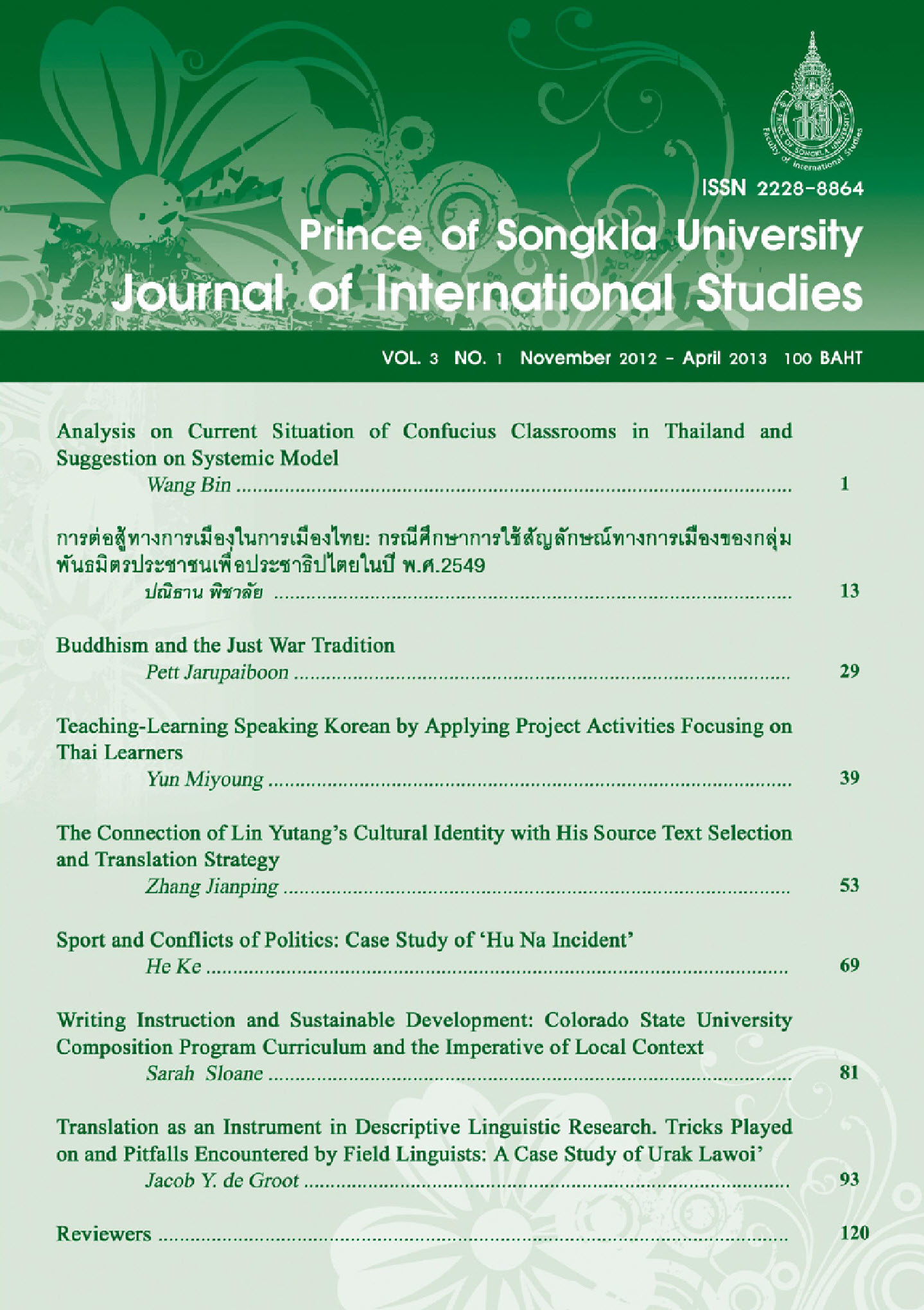Political Struggles in Thai Politics : Case of the Uses of Political Symbol by People's Alliance for Democracy in 2006
Main Article Content
Abstract
This research, applying qualitative methodology in collecting primary data and in-depth interviwe, has a major objective to examine the process of using political symbols of PAD for political struggle in 2006.
The study finds that the PAD has been using political issues as communication means in order to convince the public to agree that "the government is annihilating three dominant institutions: Nation, Religion, and Monarchy, and that the PAD is functioning themselves protecting these institutions. To be more understanding, the PAD has inculcated this idea by producing many political symbols including mottos, songs, shirts, etc. These political symbols have been broadcasted repeatedly in various media to be the process of using political symbols of PAD to overthrow Taksin Shinawatra's government in 2006.
Article Details
Statements and opinions expressed in articles herein are those of the authors and do not necessarily reflect the position of the editors or publisher.
Article, information, text, image, etc. which are published in Journal of International Studies, belong to Journal of International Studies. If anybody or any organization would like to use part or whole of them, they must receive written permission from Journal of International Studies before usage.
References
กองบรรณาธิการหนังสือพิมพ์เอเอสทีวี-ผู้จัดการรายวัน (2553). ขบวนการล้มเจ้า. กรุงเทพฯ: เอเอสทีวี-ผู้จัดการ
เกษียร เตชะพีระ (2550), จากระบอบทักษิณสู่รัฐประหาร 19 กันยายน 2549: วิกฤติประชาธิปไตยไทย. กรุงเทพฯ: มูลนิธิ 14 ตุลา.
เกษียร เตชะพีระ (2553), สงครามระหว่างสี: ก่อนถึงจุดไม่อาจหวนกลับ, กรุงเทพฯ: โอเพน บุ๊ก.
ชาญชัย ชัยสุขโกศล. (2552). เทคโนโลยีกับการต่อสู้ทางการเมืองโดยไร้ความรุนแรง: ศึกษากรณีอินเทอร์เน็ตในประเทศไทย. วิทยานิพนธ์ปริญญาดุษฎีบัณฑิต สาขาวิชารัฐศาสตร์ คณะรัฐศาสตร์ จุฬาลงกรณ์มหาวิทยาลัย,
ชาญวิทย์ เกษตรศิริ. (2551). จาก 14 ถึง 6 ตุลา, กรุงเทพฯ: มูลนิธิโครงการตําราสังคมศาสตร์และ มนุษยศาสตร์
ชัยอนันต์ สมุทวณิช. (2535), ข้อมูลพื้นฐานกึ่งศตวรรษแห่งการเปลี่ยนแปลงการปกครองไทย กรุงเทพฯ: สมาคมสังคมศาสตร์แห่งประเทศไทย
นครินทร์ เมฆไตรรัตน์. (2553), การปฏิวัติสยาม พ.ศ. 2475. กรุงเทพฯ: สํานักพิมพ์ฟ้าเดียวกัน
ป่วย อึ้งภากรณ์. (2551). "ความรุนแรงและรัฐประหาร 6 ตุลา 2519." ใน จาก14 ถึง 6 ตุลา ชาญวิทย์-ธํารงศักดิ์, บรรณาธิการ กรุงเทพฯ: มูลนิธิโครงการตําราสังคมศาสตร์และมนุษยศาสตร์.
ผู้จัดการฉบับพิเศษ. (2535), บันทึก "ภาพ-คําพูด-เหตุการณ์" ประวัติศาสตร์ พฤษภาคมทิฬ. กรุงเทพฯ: สํานักพิพม์ผู้จัดการ
พีระพงษ์ สิทธิอมร. (2549), ประวัติศาสตร์การเมืองไทย. กรุงเทพฯ: ซี แอนด์ เอ็น
มานิตย์ นวลละออ. (2532), สัญลักษณ์ทางการเมืองในการเมืองไทย: ศึกษาเฉพาะกรณีการใช้สัญลักษณ์ทางการเมืองในสมัยรัฐบาลจอมพล ป. พิบูลสงคราม (พ.ศ. 2481-2487) วิทยานิพนธ์ปริญญาดุษฎีบัณฑิต คณะรัฐศาสตร์ จุฬาลงกรณ์มหาวิทยาลัย
รุ่งมณี เมฆโสภณ. (2537), ประชาธิปไตยเปื้อนเลือด เหมือนมาไกล แต่ไปไม่ถึงไหน, กรุงเทพฯ บ้านพระอาทิตย์
ลิขิต ธีรเวคิน (2550), วิวัฒนาการการเมืองการปกครองไทย. กรุงเทพฯ: สํานักพิมพ์ มหาวิทยาลัยธรรมศาสตร์
ศิรินทิพย์ อรุณเรื่อ. (2550), เปิดตําราโกย: ระบอบทักษิณ. กรุงเทพ ผู้จัดการ
สมเกียรติ วันทะนะ (2533), รัฐสมบูรณาญาสิทธิ์ในสยาม, วารสารสังคมศาสตร์และมนุษยศาสตร์ มหาวิทยาลัยเกษตรศาสตร์ ปีที่ 17, 1 (มิถุนายน 2533): 23-39.
สุธาชัย ยิ้มประเสริฐ. (2534), แผนชิงชาติไทย. กรุงเทพฯ: สํานักพิมพ์สมาพันธ์ สุธาชัย ยิ้มประเสริฐ. (2551). สายธารประวัติศาสตร์ประชาธิปไตยไทย. กรุงเทพฯ: สํานักพิมพ์ พี.เพรส.
สุริยะใส กตะศิลา. (2552), วิวัฒนาการการเมืองภาคประชาชนสู่ประชาธิปไตยแบบมีส่วนร่วม กรณีศึกษาพันธมิตรประชาชนเพื่อประชาธิปไตย, วิทยานิพนธ์ปริญญามหาบัณฑิต สาขาวิชาผู้นําทางสังคม ธุรกิตและการเมือง วิทยาลัยนวัตกรรมทางสังคม มหาวิทยาลัยรัง
สุวิชชา เพียรราษฎร์ (2551). ASTV ขบถสื่อโทรทัศน์ของไทย. กรุงเทพฯบ้านพระอาทิตย์ หลวงประดิษฐ์มนูธรรม(ปรีดี พนมยงค์), (2552). เค้าโครงการเศรษฐกิจหลวงประดิษฐ์มนูธรรม. กรุงเทพฯ: สํานักพิมพ์สุขภาพใจ.
Ernst Cassier. (1946): Philosophy of Symbolic Forms, vol.3 New Haven: Yale University Press, 1953-1957, p 114.
Menair, B. (1999). AN Introduction to Political Communication. New York: Routledge.
Medhi Krongkaew. (2009). Reflection on Thailand - Australia Free Trade Agreement in Thaksin's Thailand, p.49. Thaiand: Institute of Security and International Studies.
Newman, B.L. (1999). Hand Book of Political Marketing. California: Sage Publication Inc.
Nostitz, N. (2009). Red vs. Yellow Volume 1: Thailand's crisis of identity. Bangkok: White Lotus Press.
Nostitz, N. (2009). Red vs. Yellow Volume 2: Thailand's crisis of identity. Bangkok: White Lotus Press.
Pasuk Phongpaichit and Baker, C. (2009). Thaksin. Bangkok: Silkworms Books.
Peirce, J.R. (1961). Symbol Signal and noise: the nature and process of communication. New york: Harper.
Plate, T. (2011). Conversations with Thaksin: from exile to deliverance: Thailand populist's tycoon tell his story. Singapore: Marshall Cavendish edition.
Pranger, R.J. (1968). Action, symbolism and order: the existential dimensions of politics in modern citizenship. Nashville, Ten: Vanderbilt University Press.
Sachs, J.D. (1990). Social conflict and populist policies in Latin America. San Francisco: An international Center for Economic Growth Publication.
Schramm, W. (1974). The Process and Effects of Mass Communication. Urbana University of Illinois press: United States of America.
Skorupski, J. (1983). Symbol and Theory. Cambridge: Cambridge University Press.
Sripan Rattikalchalakorn. (2009). Politics under Thaksin: Popular Support, Elite Concern In Thaksin's Thailand: Populism and Polarisation, p.16. Thailand: Institute of Security and International Studies.
Surhone, L.M. and Tennoe, M.T. (2011). Public Opinion of the 2006 Thai Coup d'Etat United States: Betascript Publishing.
Terwiel, B.J. (2011). Thailand's Political History: From the Thirteenth Century to Modern Times. Bangkok: River press.


